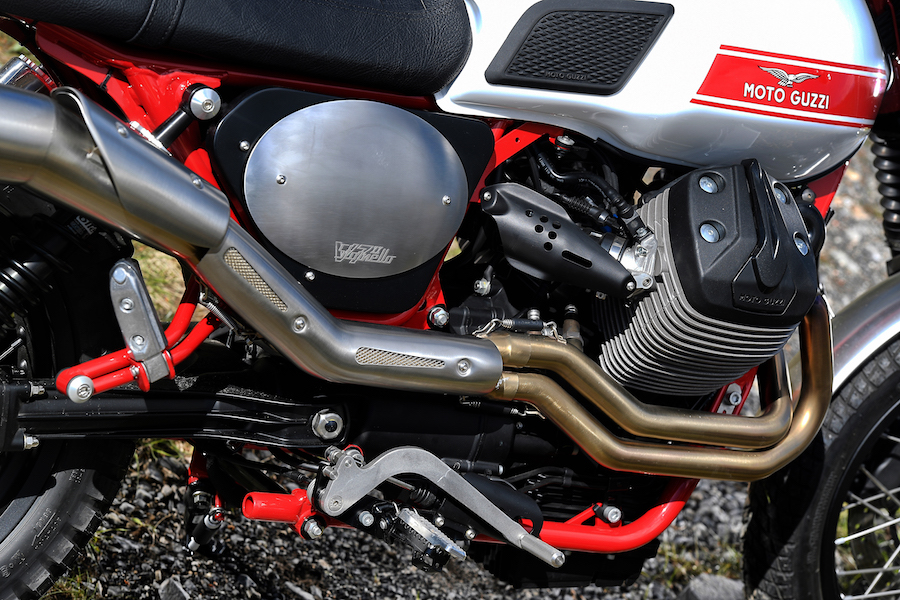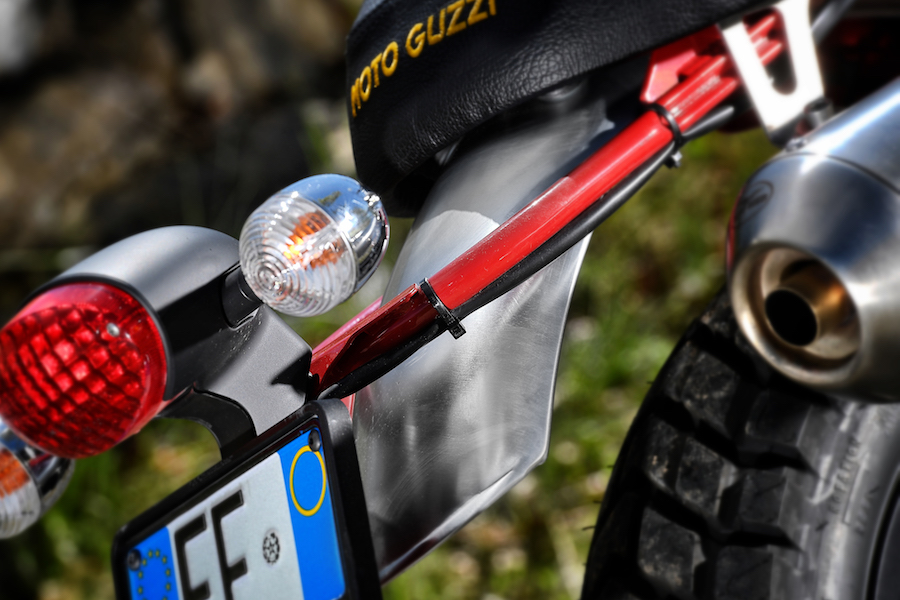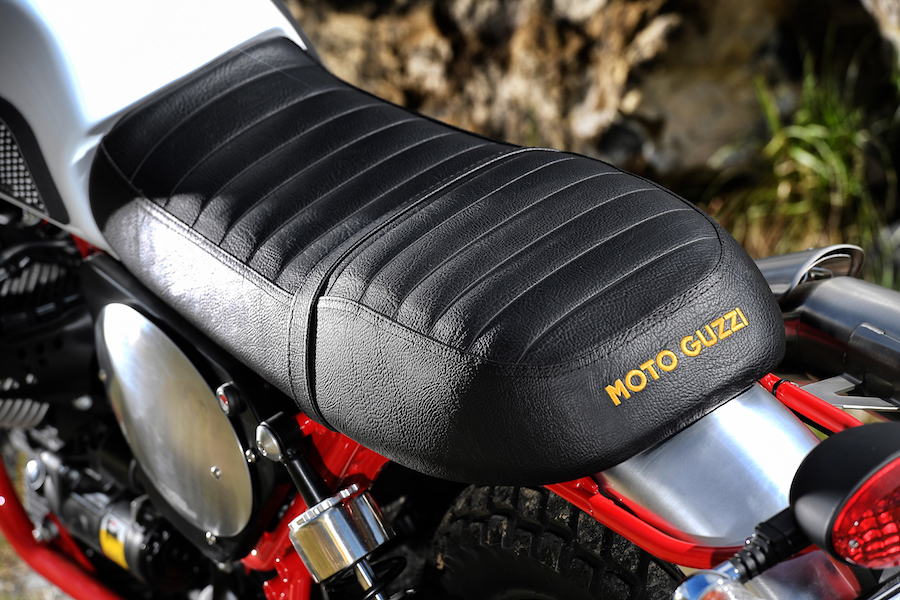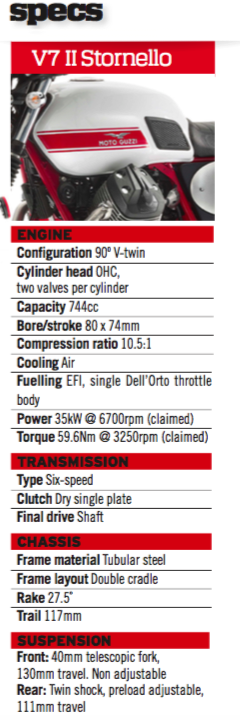As scrambler fever sweeps the globe, one of the original players returns with a limited edition special
Yep, everybody’s doing it these days – Triumph, Ducati, and BMW and Yamaha are all making scramblers, and now Italy’s most historic motorcycle manufacturer is joining in the fun. As a further celebration of its 95th birthday in 2016, Moto Guzzi has introduced a new retro-themed addition to its V7 II model range: the Stornello.
While it’s easy to make accusations of bandwagon jumping, it should be noted that the Mandello-based marque was there right at the beginning, effectively creating the street scrambler market along with Ducati in the early sixties with the original Stornello. In the Moto Guzzi museum you will find evidence of this, as well as a 1972 Stornello Scrambler that the new bike borrows its livery from. Unlike Ducati’s Scrambler, with its eye-popping range of colours, the Stornello comes in a single classic colour scheme, featuring a red frame and white 21-litre fuel tank with a red stripe. But like Ducati’s bike, a V-twin powerplant has replaced the smaller-sized single of yesteryear.
The Stornello is powered by the latest V7 II version of Guzzi’s 744cc small-block 90º V-twin motor – derived from the late Ing. Lino Tonti’s V35/V50 motor dating back to 1977. The V7 II uplift, released in 2015, saw the air-cooled OHV pushrod engine significantly improved in terms of overall quality in fit and finish, as well as in performance. It brought a 15 per cent increase in power from 31kW to 35kW at 6700, as well as a significant increase in the amount and spread of low-rpm torque – it now peaks with 59.6Nm at just 3250rpm.
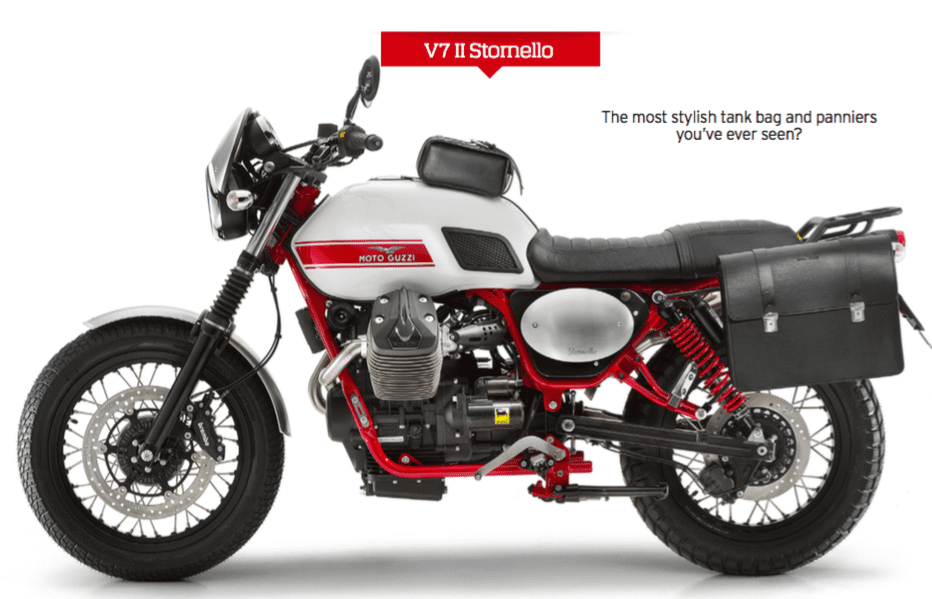
But arguably the biggest improvement introduced on the V7 II 18 months ago and featured on the Stornello is its more evenly spaced six-speed transmission, replacing the old five-speeder with its monumental throw between first and second that always invited a false neutral. The Stornello of course retains Guzzi’s trademark shaft final drive, but features a closed-up gap between first and second ratios, and fourth and fifth, with a longer new sixth. The new gear change seems light years ahead of that on past V7 Guzzi models, with crisp, quiet shifts and no danger of missing a gear. On top of that, the engine is so torquey that changing gear becomes a choice rather than a requirement. Also featured are an improved single-plate diaphragm clutch aimed at achieving an even lighter action and a more even release, as well as the V7 II’s two-channel Continental ABS and switchable single-stage traction control. Finally, unique to the Stornello is a two-into-one Arrow stainless steel high-rise exhaust running down the right side of the bike, in a good-sounding if rather disjointed-looking tribute to the bike’s notional off-road heritage.
In terms of architecture, the engine in the Stornello as on other V7 II family members has been repositioned 10mm lower in the twin-loop tubular steel frame than on the original V7, and is now tilted 4° forward towards the front axle. This has not only delivered improved aesthetics by eliminating the nose-up look of previous V7 models when viewed from the side, but together with 25mm lower footrests and a reduced 798mm height for the long seat it has also created a friendlier stance for shorter riders, including women. Yet it also delivers a more spacious riding position for taller folks, with extra knee room and the one-piece handlebar grips just falling to hand. At 1.80m I never once found my knees making friends with the jutting-out cylinder heads during the four-hour test ride.

The route took me on an enjoyable and spirited climb towards the skies along sinuous, switchback, hairpin-infested roads – a good test of the Stornello’s go-anywhere credentials, especially with the corrugations on their tarmac surfaces caused by winter frosts and snow, as well as copious tree roots. And it was a test which Guzzi’s new retro-styled adventure bike mostly took in its stride.
The light clutch and torquey engine combined with the unexpectedly sweet-shifting six-speed gearbox to make easy meat of motoring out of tight, twisty turns and up steep inclines towards the summit of the mountain pass. The Stornello’s tight steering lock makes life easier in hairpins or negotiating city streets, where the upright stance it provides helps you plan deft moves in traffic very easily. Its 186kg weight (with oil, no fuel) is light enough that the single 320mm front disc gripped by a Brembo four-piston caliper delivered just about enough stopping power even after repeated heavy use into those hairpin bends coming back downhill to the lakeside factory. It didn’t fade, and the relatively hefty 260mm rear disc with its floating two-pot caliper all made in-house by Guzzi – same as the front disc – did a good job in helping out. Serviceable is the best word to describe the Stornello’s brake package as delivered, with more aggressive pads a possible solution for anyone wanting a bit more bite. I did get the ABS kicking in over junior streams flowing down the hillside roads after torrential rain the day before my ride, and it all seemed very well controlled, ditto the MGCT traction control which did however take longer to kick in than I expected when I tried as a test to spin up the rear wheel over water. Since there’s only a single choice of setting –apart from turning it off altogether – there was nothing to be done about that.
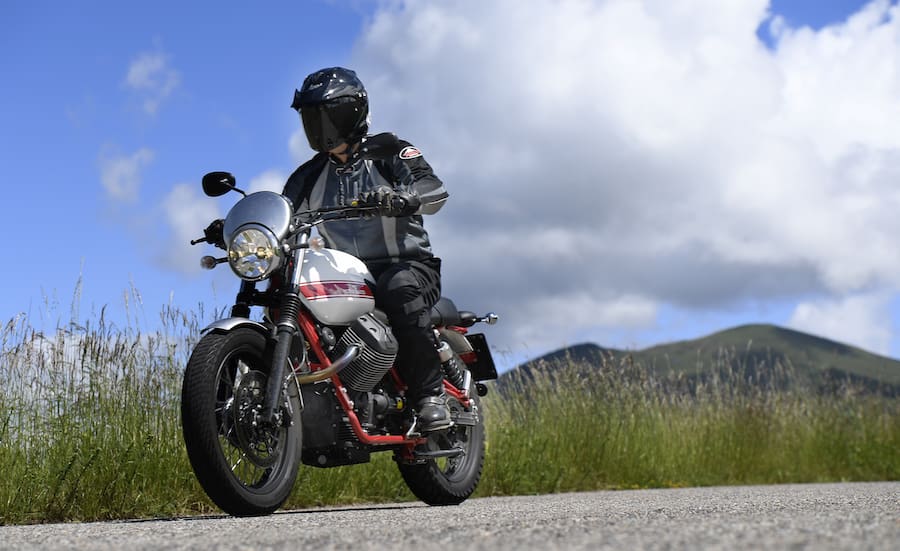
The V7 II engine is delightfully eager and willing, with a crisp but controllable pick-up from a closed throttle, and heaps of low-down grunt which allows you to crack it wide open in sixth gear from as low as 2000 rpm and drive all the way to the hard-action seven grand rev limiter with a totally linear build of power, and zero transmission snatch. Though sixth gear is pretty high, mind, and really only there for freeways, even if you can pull out of a slow turn at 50km/h in sixth gear without a hiccup. I spent most of my ride circling Lake Como in third and fourth gears, surfing the Guzzi’s torque curve for a satisfying pull uphill and on the flat, without resorting to the gear lever to row the Stornello along.
Anyway, there’s no point in revving it beyond 6000 rpm, when it starts to vibrate quite fiercely, mainly through the footrests, as well as becoming rather breathless. Operating in the bike’s 2500-5500rpm happy zone allows you to make the most of what is a very forgiving power.
Styling-wise, the Stornello’s styling is right on the money – well, apart from that slightly curious-looking exhaust – and employs heaps of metal parts rather than plastic. These include the brushed aluminium mudguards that are apparently hand-beaten, the trio of alloy competition number plates, and the black-anodised injector covers, side panels and handlebar, plus the detachable tarmac-friendly inserts that fit over the off-road footrests’ knurled base. The rubber knee grips on the fuel tank flanks are a nice retro touch, as is the long stitched seat with embroidered logo at the rear, and the rubber gaiters on the 40mm Guzzi-made fork legs.
In spite of being non-adjustable, the front suspension gave pretty good damping over broken tarmac throughout its 130mm travel, and continued to do so after I ventured off road along a rough-surfaced mountain track to explore the Alpine countryside via what the Italians call strade bianche (white roads). Even with the semi-knobbly GoldenTyre rubber fitted, you wouldn’t want to go too far off road on the Stornello. But the combo is great for hard-packed dirt tracks, as I found out in the hills overlooking Lake Como. Magic.
That’s where I came to terms with the only real defect on the Stornello: the wooden-feeling pair of Spanish-made Ollé rear shocks. These deliver just 111mm of wheel travel and are adjustable only for spring preload. At lower speeds they work okay, but they bottom out harshly as soon as you hit a bumpy ridge or a pothole in the tarmac, or land even a gentle jump off road. They mainly just need better damping, and looking online at Moto Guzzi forums it’s evident that this is a recurrent complaint from owners of other members of the V7 II family, apart from the Racer, whose Bitubo shocks come with adjustable compression damping. Strange that Guzzi didn’t fit these to the Stornello, especially considering its higher price and limited edition status – but it seems there’s a ready fix off the Guzzi dealer’s parts shelf for what is the only real disappointment on the bike.
Apart from that the Stornello handles sweetly, with light but precise steering thanks to the 18-inch front wheel, especially rounding a hairpin at little more than walking pace where some other bikes like to drop into the apex as you crank them over. It’s also stable at higher speeds, though I’ll admit I only saw the speedo exceed 120km/h a couple of times riding alongside the lakeshore back to Mandello. Build quality is high, reflecting the investment which Piaggio has made in new machinery on the Moto Guzzi factory’s revamped assembly line, and I doubt very much it’ll take them very long to sell out those 1000 units, even at the slightly premium price.
The Moto Guzzi V7 II Stornello has been described in print by an Italian mate of mine as having the charms of a special, the looks of a scrambler, and the ease of a scooter. Wish I’d thought of that – because that’s exactly what it is.
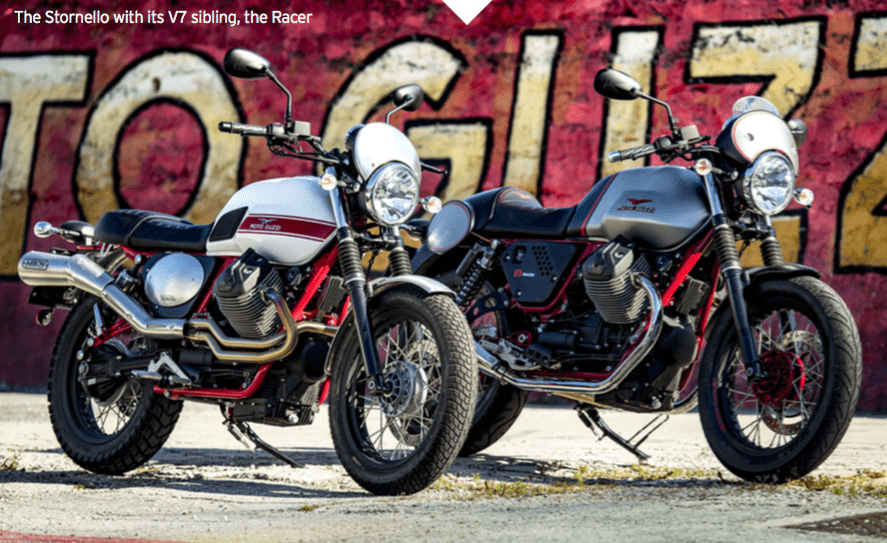
The Stornello- A scrambled history
The original Moto Guzzi Stornello debuted late in 1959 in 125cc guise, and went on to become one of the Italian factory’s best-selling models, remaining in production until 1974.
With the Fiat 500 eating massively into all Italian motorcycle manufacturers’ sales volume and profits after its 1955 appearance, Guzzi bosses decided to develop an affordable and easy-handling four-stroke single with a hint of sporting flair as a counter to the minicar’s appeal as a family conveyance. The Stornello was the result – aptly named after the starling, a feisty, noisy and gregarious bird with a love of wide open spaces (according to my friendly local ornithologist, whom I happen to be married to!).
The Stornello’s design was entrusted to Guzzi’s famous chief engineer Giulio Cesare Carcano, creator of the firm’s famed 500cc V8 GP racer and its multi-world champion ultra-lightweight 250/350 singles. The Stornello was Carcano’s first streetbike design, and its pushrod OHV wet-sump engine with four-speed transmission featured a single air-cooled cylinder inclined forward by 25°, It produced 5.2kW at 7200rpm, delivering a top speed of 100km/h. The twin-loop open cradle tubular steel frame eventually was entirely robot-welded – the first time this technology was used in the Italian motorcycle industry.
The Stornello quickly proved successful, first as a practical everyday bike, then even more so later on as Guzzi developed sporting variants. Of these, the 6.3kW/110km/h clipon-equipped Sport arrived first in 1961. Then in 1962 came the 125 Regolarità – a dual-purpose model producing 8.9kW at 8000rpm which provided the basis for some years of success for Moto Guzzi in off-road competition, at both National level and in the ISDT. This came originally with Guzzi’s own factory team, before this was disbanded at the end of 1964. The task of preserving the marque’s supremacy was then entrusted to customers, with the introduction of a replica of the factory racer under the Stornello ISDT label manufactured up until 1967.
That year saw a major overhaul of the entire range of Stornello models, which had essentially been responsible for Moto Guzzi remaining in business long enough for its long-term survival to be ensured by the debut of the first transverse V-twin shaft-drive V7 model in 1967, the year that the ailing company was taken over by the Italian state. Later that year the 125cc Stornello range was revamped into the Sport America touring model, the Sport Italia sporting version complete with clip-ons and racy styling, and the dual purpose Scrambler. Next up were the 160 variants of the Sport models (the Scrambler remained at 125cc for competition classification reasons), obtained by boring out the cylinder to ‘square’ 58 x 58mm dimensions for a 153cc engine that delivered 9.4kW at 7500 rpm, and made the Stornello 160 good for a top speed of 118km/h.
At the 1969 Milan Show the final version of the Stornello was introduced, with revised, updated styling and a five-speed transmission. This didn’t enter production until 1971, but it helped lift production to its all-time high of 46,487 units in a single year. Although the model was only manufactured until 1974, it continued to be listed for a further year to sell off unsold stock.
The Stornello was discontinued after Moto Guzzi was taken over by Alessandro de Tomaso, and replaced by a badge-engineered 250cc two-stroke twin manufactured in the Benelli factory, which the Argentinian entrepreneur also by now owned. It wasn’t until 40 years later that a Guzzi model again carrying the Stornello name made its debut at the 2015 EICMA Milan Show, and has now entered production.

Guzzi going great guns
The Stornello’s release comes on the back of a 24 per cent increase in deliveries for Moto Guzzi in 2015, when it sold 7880 motorcycles – a good step up from the 6,358 shipped in 2014. This is certainly due in part to the 31.4 million (A$46.4 million) that Guzzi’s Piaggio Group owner invested in R&D on new models last year across the entire model range, including the Vespa scooters which have kept Guzzi and Aprilia afloat through all the recent hard times, ready to take advantage of the current upswing in the global market, and especially in Italy.
Piaggio says it has strengthened its position on the European two-wheeler market, closing the first quarter of 2016 with an overall market share of 13.6 per cent (versus 13.1 per cent in the first quarter of 2015) and a 24.5 per cent market share in scooters (approximately 11 percentage points ahead of its second European competitor). It claims to have generated an improvement of 32.8 per cent in global revenues from the first quarter of 2015, with the Vespa brand strengthening its presence in the European market, with revenues up by 7.1 per cent.
Piaggio Group revenues also improved in its motorcycle sector, with an overall increase of 9.7 per cent compared to a year ago. This result was assisted by higher sales for the Moto Guzzi California line (up 5.3 per cent), while sales for its Aprilia motorcycle brand were driven upwards by its V4 Supersport models (RSV4 and Tuono 1100RR), where shipments rose sharply, with a 62.5 per cent growth in sales volume for the RSV4 1000 range, and a 104.4 per cent lift for the Tuono models – indeed, more than double the sales of one year ago.
In the first quarter to 31 March 2016, the Piaggio Group sold 74,800 two-wheelers worldwide (versus 74,200 in the same period one year ago), generating net sales of AU$307.9 million, an improvement of 2 per cent from the first quarter of 2015. The figure includes spares and accessories. The total workforce of the Piaggio Group as at 31 March 2016 numbered 7074 employees, including 3620 in Italy, basically unchanged from the previous year.
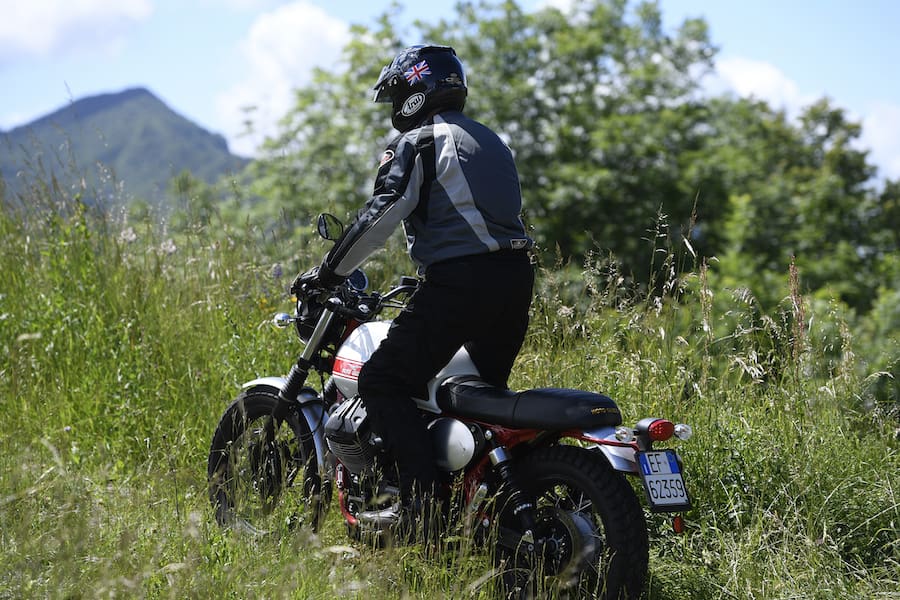
TEST ALAN CATHCART PHOTOGRAPHY MILAGRO
